Introduction to fossil fuels
Coal, oil and gas are the three fossil fuels. They are all non-renewable energy sources and using them helps cause climate change.
In this article you can learn about:
- What fossil fuels are
- How fossil fuels formed
- What we use fossil fuels for
- What the advantage and disadvantages of fossil fuels are
This resource is suitable for energy and sustainability topics for primary school learners.
Video - Fossil fuels
In this video, learn about different fossil fuels and what the advantage and disadvantages of fossil fuels are.
Meet coal, oil and gas.
They're non-renewable energies and…
hang on a second…
Coal. Coal!
Stop making such a mess.
You too oil.
Try and be more like your brother, gas.
That's very rude, coal!
He does not smell.
Anyway, their journey started during THE TIME OF THEDINOSAUR.
Dead plants and animals, on land and in the sea, were buried under layers of earth and sand that slowly became sedimentary rock.
Over millions of years, the dead plants and animals were compressed and heated up and, in the process, turned into coal, oil and gas.
And that's why they're called fossil fuels – because they come from fossilised plants and animals.
People have been using them for at least 3,500 years, when some bright spark had the idea of popping a piece of coal on a fire.
But we're running out of them – soon there won't be any fossil fuels left.
And they're also very messy, polluting the air and contributing towards climate change.
The fossil fuel we use most in Scotland is gas.
Gas is pumped out from under the sea bed and some of it is sent in pipe lines to Peterhead power station in Aberdeenshire.
At the power station, gas is burnt with hot compressed air.
This turns the turbines, transforming chemical energy into mechanical energy.
Which the generator then converts into electricity.
And that's not gas's only trick, he also provides most Scottish homes with heat and hot water.
And, of course, we still use oil to power our cars and make plastic.
And we need coal to make steel.
So, on the plus side fossil fuels are cheap, reliable and can beused to make lots of stuff.
But on the downside they're messy…
Coal! Don't touch that!..
they're non-renewable and they contribute to climate change.
Which is why, more and more, Scotland is trying to replace coal,oil and gas with renewable energies.
What are fossil fuels?
Fossil fuels were formed over millions of years from the remains of dead animals and plants.
Coal comes from trees and plants.
Oil and gas come from tiny sea animals and plants (plankton).
These remains were buried under layers of sand and mud and compressTo squash, squeeze or flatten something by pressing it. under the ground and sea bed. As the temperature and pressure increased over time, they eventually turned into fossil fuels.
What are fossil fuels used for?
fossil fuelsFuels that come from the Earth. Fossil fuels are all old life forms that have decomposed and been compressed over a long period of time under ground or under the sea. Coal, oil and gas are fossil fuels. can all be burned to release their energy:
- gas is used for central heating in our homes
- oil is used to make petrol and diesel fuel for cars and other vehicles
- coal can be burned on open fires to heat houses
All fossil fuels can be burned in power stations to generate electricity. They have some other important uses:

Image caption, Steel (from coal)
Coal is used to turn iron into steel, which is used for building and making all sorts of machines and vehicles. (Andrew Paterson / Alamy Stock Photo ; Anton Starikov / Alamy Stock Photo)
Image caption, Petrol and plastic (from oil)
Oil is used to make petrol which fuels cars. Oil is also used to make plastics, which can be moulded and shaped to make toys, packaging, machine parts and even clothes. (Anton Starikov / Alamy Stock Photo ; Michael Burrell / Alamy Stock Photo)
Image caption, Heat and hot water (from gas)
Gas is used to provide homes with heat and hot water. Gas boilers burn gas to heat up the water that goes into radiators. Gas is also used in many homes for cooking. (Victor Koldunov / Alamy Stock Photo ; incamerastock / Alamy Stock Photo)
1 of 3
How do we turn fossil fuels into energy?
Gas is Scotland’s most commonly used fossil fuel and is found under the sea bed.
- A gas platform drills down into the sea bed. Gas is pumped through pipes up to the platform.
- A natural gas pipeline pumps the gas to a power station.
- combustion chamberAn enclosed space in which fuel is burned. fire hot compressed air into the gas.
- The gas burns and its chemical energy changes to heat energy. This make the air get hotter and expand.
- Heat energy changes to kinetic energy as the expanding hot air is pushed through pipes to the turbines.
- The hot air turns turbineA turbine is a machine that turns the movement of liquid or gas into energy that can be used. In a simple turbine water or air push against turbine blades and spin them round. The spinning blades turn a long pole called a shaft. The shaft can then turn other pieces of machinery, such as a generator that is used to produce electricity..
- Finally, the spinning turbines turn generatorA machine that is used to make electricity. When the generator head is turned, this energy is converted to electrical energy. which convert kinetic energy into electricity.
Discover more about how we generate electricity here: Generating electricity
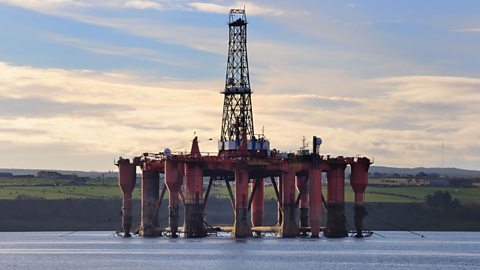
Image caption, An oil and gas drilling platform on the Cromarty Firth in Scotland. (Douglas Carr / Alamy Stock Photo)
Image caption, An oil refinery in Ontario, Canada. (Jim West / Alamy Stock Photo)
1 of 2
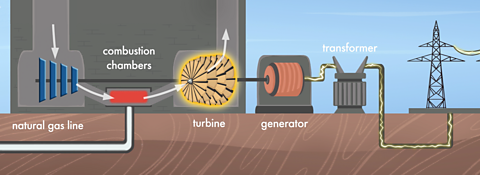
What are the problems with fossil fuels?
- They are non-renewable
We are running out of fossil fuels because they are non-renewableNatural resources that cannot be replaced after they are used. This means that they exist in a fixed amount on Earth. Fossil fuels such as coal, oil and gas are all non-renewable resources.. The process of creating them took millions of years and humans have taken a lot of fossil fuels out of the ground already.
Learn about the difference between renewable and non-renewable energy: What is renewable and non-renewable energy?
- They damage the environment
Fossil fuels are messy and not good for the environmentOur physical surroundings on Earth, including all living and non-living things.. Burning fossil fuels creates carbon dioxide which traps heat from the Sun in the Earth's atmosphere. This is one of the causes of global warmingThe increase in the Earth's average temperature due to the greenhouse gases released in to the environment when people burn fossil fuels..
Other gases released cause pollution which is bad for our health and for other living things. Oil leaks and frackingRemoving oil and gas that is trapped in underground rock by injecting liquid into the rock at high pressure. can pollute ground and water and harm wildlife.
- They can be dangerous
Coal mines and oil and gas rigs can be dangerous places to work. Accidents can cause death or injury.
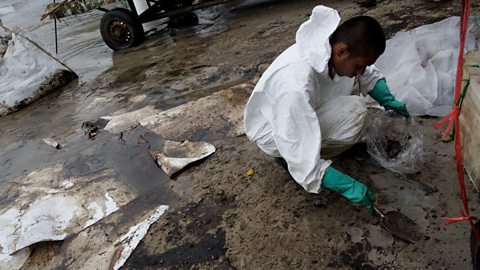
The advantages and disadvantages of fossil fuels
Advantages of fossil fuels
Fossil fuels are cheap to turn into energy and they are reliable. They will produce energy at all times and when oil, gas or coal is found, it is usually in large amounts.
They contribute to making lots of different, useful things, for example things made from steel and most plastics.
Fossil fuels can be stored and transported. This makes them easy to use as fuel for cars and other vehicles or to heat houses that aren't supplied with electricity.
Disadvantages of fossil fuels
Fossil fuels are messy and when things go wrong they can cause pollution, which is bad for the environment. Oil spills and gas leaks can happen and pollute the sea, coast, ground or rivers. This can damage or kill wildlife.
Some fossil fuels are dangerous to get. There are many examples of accidents in coal mines and on oil rigs that have caused injury and death to the workers.
Fossil fuels are non-renewable which means once we use them, they run out.
Burning fossil fuels is bad for the environment and is one of the largest contributors to climate changeThe change in the usual conditions of weather (temperature, wind, rainfall etc.) on Earth over a long period of time. The climate has changed throughout the history of Earth, but current climate-change refers to an increase in global temperature..
When fossil fuels burn they give off air pollution. This is bad for human health (especially if you have asthma or heart disease) and animal health.

Key words about fossil fuels
Sorry, something went wrongCheck your connection, refresh the page and try again. - Natural resources that cannot be replaced after they are used are non-renewable. This means that they exist in a fixed amount on Earth. Fossil fuels such as coal, oil and gas are all non-renewable resources.
Sorry, something went wrongCheck your connection, refresh the page and try again. - Rock made when sediment, such as sand, mud and pebbles, builds up in layers. Over time, these layers are squashed under more and more layers of sediment. Eventually, heat and pressure turns the layers into rock. Sedimentary rock can form in deserts, lakes, rivers and seas.
Sorry, something went wrongCheck your connection, refresh the page and try again. - The change in the usual conditions of weather (temperature, wind, rainfall etc.) on Earth over a long period of time. The climate has changed throughout the history of Earth, but current climate change refers to an increase in global temperature.
Sorry, something went wrongCheck your connection, refresh the page and try again. - The increase in the Earth's average temperature. It is caused by the increase in greenhouse gases, like carbon dioxide, in the atmosphere. These gases trap heat from the Sun.
Sorry, something went wrongCheck your connection, refresh the page and try again. - The release of carbon into the earth’s atmosphere, which contributes to climate change.
Sorry, something went wrongCheck your connection, refresh the page and try again. - About three quarters of carbon emissions are carbon dioxide gas. This can stay in the atmosphere more that one hundred years.
Sorry, something went wrongCheck your connection, refresh the page and try again. - About one fifth of carbon emissions are methane gas. Methane stays in the atmosphere for about ten years.
Sorry, something went wrongCheck your connection, refresh the page and try again. - Gases and particles (like dust or smoke) in the air that can damage the environment, plants, animals and human health.
Sorry, something went wrongCheck your connection, refresh the page and try again. - An enclosed space in which fuel is burned.
Sorry, something went wrongCheck your connection, refresh the page and try again. - Fossil fuels are made of different natural chemical which store lots of energy. Chemical reactions, like burning, can release this energy so that we can use it.
Sorry, something went wrongCheck your connection, refresh the page and try again. - A simple turbine has a shaft and blades that turn movement in to energy. Usually, water or air push the blades and turn the shaft. Turbines are used to turn the generator.
Sorry, something went wrongCheck your connection, refresh the page and try again. - A machine that is used to make electricity. When the generator head is turned, this energy is converted to electrical energy.
Test your knowledge
Quiz
Challenge

Make a persuasive poster to show your point of view on fossil fuels
What is your view on fossil fuels? Do you agree with our use of them or not?
Make sure you list the advantages or disadvantages to improve your argument.
Here are some tips about designing a poster: How to make a poster
More on Sustainability
Find out more by working through a topic
- count18 of 28
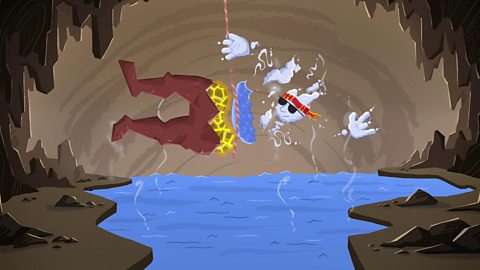
- count19 of 28
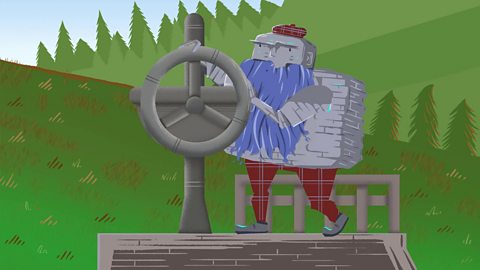
- count20 of 28
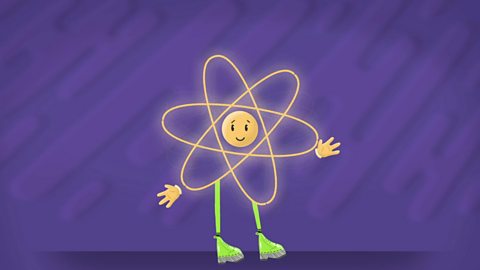
- count21 of 28
